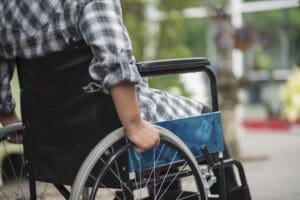All types of work accidents – occupational accidents or diseases
Work accidents can occur at any time and to any worker, whether it be falling in the work area due to an obstacle, or falling from a height, such as from a ladder, scaffolding or any other elevated work surface, such as a ceiling or roof. Work accidents can also occur as a result of injury by a machine or any other work-related reason. What all the above examples have in common is that they are occupational accidents, which can be traced back to a specific time and place, and which occur suddenly and cause bodily harm.
Nonetheless — there is another type of accident that cannot be traced back to a specific time and place, but rather occurs over time, as a result of repeated events which add up little by little, eventually causing an employee bodily harm. This is what is known as an “occupational disease”.
Work accidents are not limited to events that occur in the workplace or factory where one works, but also outside it, whether it be in a place where the injured party was sent to perform a certain task on behalf of his/her employer, or on his/her way to work or back home from it, including traffic accidents.

Occupational accident:
As mentioned, one type of work accident is a sudden event that can be pinpointed to a specific time and place, and that causes harm to an employee, whether physical or mental. Due to the nature of these types of accidents, they are usually incidents which are easy to identify, and in most cases, it is even possible to find the reason for their occurrence. As a result, it is also possible to identify the exact date of the accident, for the purpose of calculating the statute of limitations which defines how long after the event can a lawsuit be filed, usually 7 years.
Occupational disease:
The conditions described above do not apply to the type of “accident” known as “occupational diseases”. These are, as their name implies, diseases that develop while working, occurring slowly over time and leading to a physical disability that is directly caused by the work, not as a result of an existing disease in the employee’s body unrelated to their work. The occurrence of these work accidents is also defined as “microtrauma”, i.e., repeated micro-injuries suffered in the workplace, which eventually end up causing an occupational disease, also considered a type of work accident.
As an example, this type of accident can occur as a result of an employee being exposed to loud, harmful noise in the workplace over a period of time, causing hearing damage which can lead to hearing impairment as well as permanent tinnitus. Another example is carpal tunnel syndrome (CTS), which workers can develop as a result of using vibrating devices and constantly using their hands. A third example is hoarseness, which usually occurs among teachers in educational institutions. Constant use of their vocal cords at high volumes can cause vocal cord polyps and eventually lead to an occupational disease.
It is important to note that, as a rule, there is a limited list of occupational diseases of this type, but the list can be expanded to include new diseases, in the event that an employee manages to prove that a disease he/she is suffering from has developed little by little as a result of work conditions, and over time became an occupational disease.
How do I know if I have an occupational disease?
As mentioned, occupational diseases are not as easy to identify as typical work accidents, as they cannot be pinpointed to a specific time and place. For this reason, it is very important to find out if you might be suffering from some kind of occupational disease, in order to take the right course of action to receive appropriate compensation.
As a rule, the primary institution that determines whether or not an event can be considered a work accident is the National Insurance Institute. For an accident or disease to be recognized as a work accident, you must file a claim with this institute for either typical work accidents (as described above) or occupational diseases.
The examples we gave above suggest a number of possible occupational diseases, which are caused according to the type of work we are engaged in. As an example: if we work in a factory or workplace where there is noise, and over time we feel that we have suffered hearing loss and/or constant tinnitus, we may need to be under the medical supervision of an ear, nose and throat specialist, and we may complain of hearing impairment and/or constant tinnitus in our ears. It is very likely that a hearing specialist will send us to perform a hearing test, which can determine if we are indeed suffering from a hearing impairment, and, among other considerations, the test also takes the patient’s reliability into account.
Regarding constant tinnitus – this is a completely subjective complaint, which is mainly measured based on the patient’s answers and his/her credibility, in addition to the work conditions. In most cases, constant tinnitus has no cure, but nevertheless, as long as we continue to suffer from it, we must contact medical institutions again and again, whether it be our family doctor or the ear, nose and throat specialist, and lodge complaints about it.
Non-permanent tinnitus does not confer any disability rating, whereas permanent tinnitus, in cases where the examiner is convinced, confers at least 10% disability.
Tracks to file claims:
Track I – National Insurance Institute:
In the case of a work accident, whether an accident or an occupational disease, you must first file a claim with the National Insurance Institute to have the accident recognized as a work accident. The claim must be filed within a period of one year from the event, and in the case of an occupational disease which is long-term, the claim must be filed within 12 months following the disease’s discovery. After the accident or illness is recognized as a work-related injury, it is possible to receive injury compensation for the days spent absent from work. In addition, you can then apply for work disability, which requires undergoing an examination by a medical committee on behalf of the National Insurance Institute, so that it can determine whether your disability is temporary or permanent.
Track II – Tort compensation claim:
This course of action is only possible if the accident or illness was caused as a result of negligence by the employer (the offending party). In such cases, the employer is obligated to compensate the victim for the bodily harm suffered, with the aim of restoring matters to the way they were before the accident or illness. The legal basis for this kind of claim is the Tort Ordinance (new version).
What documents are required to file a tort claim?
Based on the above, it is extremely important to provide basic, essential documents concerning both the issue of liability and the extent of the damage, such as photos of the scene of the incident, the hazard/obstacle/faulty ladder (if relevant), a list of witnesses, if there are any, and documents and medical records linking the incident to the damage suffered. In this context, the proximity between the date/time of the incident and the first request for medical treatment is of utmost importance. At a later stage the medical situation will naturally need to be assessed and a medical opinion provided, following consultation with a medical expert in the specialty related to the damage suffered.
Because it is a work accident, the injured party will also be required to present a BL/250 form, which they should receive from their employer immediately after the accident, for the purpose of receiving medical treatment covered (in part) by the National Insurance Institute.
If you have questions or if you need legal assistance from an attorney specializing in National Insurance and Israeli tort law, you are welcome to contact us. Our offices are located in Jerusalem and Tel Aviv.
מאמרים מומלצים

